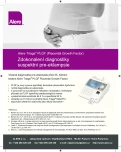Genetic aspects of pelvic floor defects and stress urinary incontinence in women
Authors:
P. Lukáč 1; K. Biringer 1; J. Siváková 1; M. Hrtánková 1; Z. Lasabová 2; J. Danko 1
Authors‘ workplace:
Gynekologicko-pôrodnícka klinika JLF UK a UNM, Martin, Slovenská republika, prednosta prof. MUDr. J. Danko, CSc.
1; Ústav molekulovej biológie JLF UK a UNM, Martin, Slovenská republika, vedúca doc. RNDr. Z. Lasabová, PhD.
2
Published in:
Ceska Gynekol 2014; 79(5): 382-387
Overview
Objective:
An overwiev of the genetic aspects of pelvic floor defects and stress urinary incontinence in women.
Design:
A review article.
Setting:
Department of Gynecology and Obstetrics, Jessenius Faculty of Medicine in Martin, Comenius University in Bratislava, Slovak Republic.
Methods:
An analysis of the literature using database search engines PubMed, BLAST and Ensembl in field of POP and SUI.
Results:
Pelvic organ prolapse (POP) and stress urinary incontinence (SUI) affect a large number of women and often requires surgical correction. Moreover, these diseases are not only individual health but also social and economic burden on patients and society. It is possible to prevent or at least timely intervene these pathologies by screening of risk patients. The incidence of these disorders leads to find possible genetic factors. In ethiopathogenetic studies of pelvic floor defects and stress urinary incontinence it is looking for genes associated with these diseases and optimization of molecular biology methods is necessary to determine the possible gene mutations or polymorphism site. Selection of relevant genetic factors tend to clarify the pathomechanism of SUI and POP that can greatly affect their current diagnostics and therapeutics.
Keywords:
prolapse, stress urinary incontinence, polymorphism, gene expression
Sources
1. Cartailler, JP., Khoshnoodi, J., Alvares, K., et al. Molecular recognition in the assembly of collagens: Terminal noncollagenous domains are key recognition modules in the formation of triple-helical protomers. J Biol. Chem, 2006, 281(50), p. 38117–38121.
2. Čihak, R., et al. Anatomie. 2. vyd. Praha: Grada, 2011, s. 470.
3. Daniels, JT., Cambrey, AD., Occleston, NL., et al. Matrix metalloproteinase inhibition modulates fibroblasts – mediated matrix concentration and collagen production in vitro. Invest Ophthalmol Vis Sci, 2003, 44(3), p. 1104–1110.
4. Ferrari, MM., Rossi, G., Biondi, ML., et al. Type I collagen and matrix metalloproteinase 1, 3 and 9 gene polymorphisms in the predisposition to pelvic organ prolapse. Arch Gynecol Obstet, 2012, 285(6), p. 1581–1586.
5. Chen, C., Hill, LD., Schubert, CM., et al. Is laminin gamma-1 a candidate gene for advanced pelvic organ prolapse. Am J Gynaecol Obstet, 2010, 202(5), p. 505–510.
6. Chen, HY., Chung, YW., Lin, WY., et al. Collagen type 3 alpha 1 polymorphism and risk of pelvic organ prolapse. Am J Obstet Gynecol, 2008, 103(5), p. 55–58.
7. Kim, BC., Kim, W.Y., Park, D., et al. SNP@Promoter: a database of human SNPs (Single Nucleotide Polymorphisms) within the putative promoter regions. BMC BioInformation Center, 2008, 9, S2, p. 1186–1192 .
8. Latchman, DS. Transcription factors: an overview. Int J Biochem Cell Biology, 1997, ISSN 1357–2725.
9. Li, B., Zhang, QF., Lin, XY., et al. Expression and significance of elastin and fibulin-5 in anterior vaginal tissue of women with pelvic organ prolapse. Zhonghua Fu Chan Ke Za Zhi, 2009, 44(7), p. 514–517.
10. Muiznieks, L., Weiss, A., Keeley, F. Structural disorder and dynamics of elastin. Biochem Cell Biol, 2010.
11. Nimwegen, E. Scaling laws in the functional content of genomes. Trends Genet, 2003.
12. Nygaard, I., Turvey, C., Burns, TL., et al. Urinary incontinence and depression in middle-aged United States women. Obstet Gynecol, 2003, 101(1), p. 149–156.
13. Petr, J. Odhalen gen pro „křehké kosti“. (online) 10/2006 (cit . 2014.2.25 http://www.osel.cz/index.php?clanek=2203).
14. Silbernagel, S., Lang, F. Atlas patofyziologie člověka. 1. vyd. Praha: Grada Publishing, 2001, s. 404.
15. Söderberg, MW., Byström, B., Kalamajski, S., et al. Gene expressions of small leucine – rich repeat proteoglycans and fibulin-5 are decreased in pelvic organ prolapse. Mol Hum Reprod, 2009, 15(4), p. 251–257.
16. Wang, L., Han, LY., Li, HL. Etiological study of pelvic organ prolapse and stress urinary incontinence with collagen status and metabolism. Zhonghua Yi Xue Za Zh, 2013, 93(7), p. 500–503.
17. Wu, JM., Visco, AG., Grass, EA., et al. Matrix metalloproteinase-9 genetic polymorphisms and the risk for advanced pelvic organprolapse. Obstet Gynec, 2012, 120(3), p. 587–593.
18. Zhang, SQ., Zhang, LL., Yu, H. Expression of elastin, lysyl oxidase and elafin in the cardinal ligament of women with pelvic organ prolapse. Zhonghua Fu Chan Ke Za Zhi, 2008, 43(9), p. 675–679.
Labels
Paediatric gynaecology Gynaecology and obstetrics Reproduction medicineArticle was published in
Czech Gynaecology

2014 Issue 5
Most read in this issue
- Condylomata acuminata (genital warts)
- Preeclampsia in pregnancy – prediction, prevention and further management
- Vaginal breech delivery after 36 week of pregnancy in a selected group of pregnancy – analysis of perinatal results in years 2008–2011
- Extramammary Paget´s disease of the vulva – a case report
